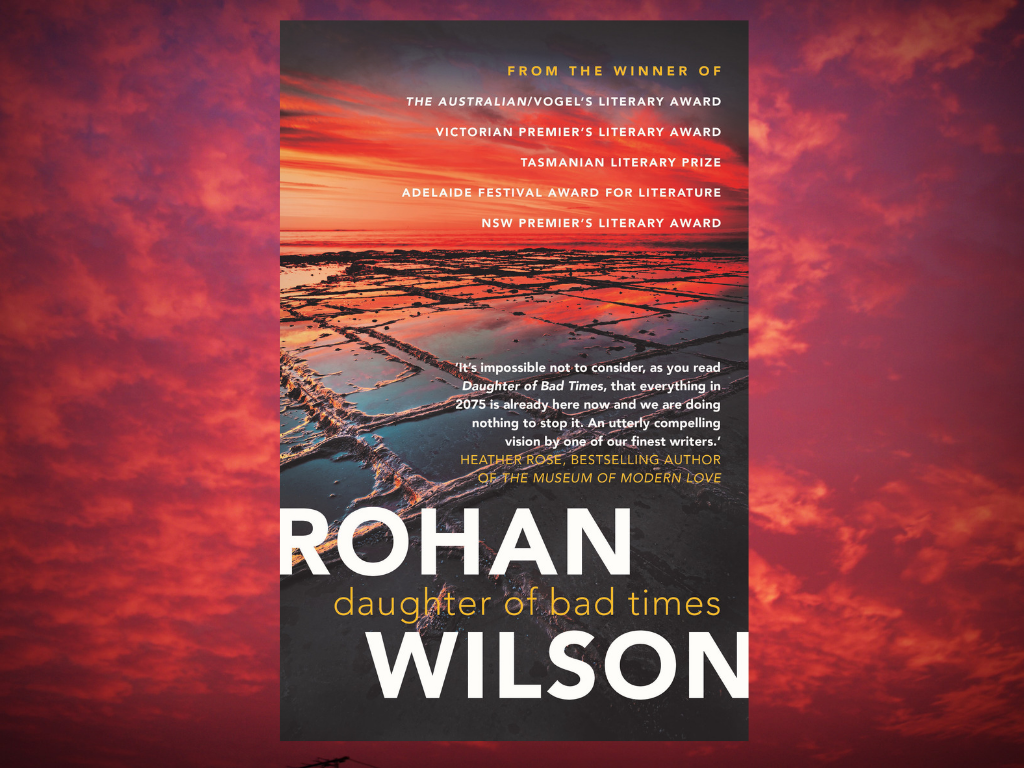
Rohan Wilson’s latest novel, Daughter of Bad Times is a novel with an extremely global outlook, but this may just be its problem.
The novel follows two protagonists, Rin Braden and Yamaan Ali Umair, two lovers from very different circumstances. Rin is the daughter of Alessandra Braden, the CEO of Cabey-Yasuda Corrections, a company which owns and operates prisons and immigration detention camps all over the world. Yamaan is a refugee, one of the few survivors of a tsunami which wiped out the few islands in the Maldives which remained above sea level.
When the novel begins, Yamaan is living in Eaglehawk MTC, an immigration detention camp located in Tasmania where environmental refugees are offered the chance to enter Australia in exchange for a year’s work manufacturing ‘TabaPets’ and other sundry items under the ominously named ‘Migrating with Dignity’ program. Rin, who has believed Yamaan to be one of the dead, is relieved to find her former lover alive, but horrified to see the reality of the situation for Yamaan and his fellow inmates. She vows to get Yamaan out of there, even if it means taking her own mother’s company down in the process.
Daughter of Bad Times is set around 2075 but it’s clear from the outset that Rohan Wilson wants to draw a parallel between the almost-dystopian future presented in the novel and the current situation faced by refugees. There are parts of this that are done extremely well, including the use of acronyms, euphemisms and political double speak on the part of the governments and corporations involved to distance themselves from the human beings at the heart of their money-making schemes. The novel intersperses chapters told from the points of view of our two protagonists with transcripts from the official inquest into the riot at the heart of the novel, including one scene in which a representative of the AFP ties the questioner up in knots refusing to acknowledge a link between the actions of the AFP and the death of an inmate.
At times, its compelling reading, but at times the novel stretches itself too far. The relationship between Yamaan and Rin, supposedly the catalyst for everything, seems to be purely based on sexual gratification and aggravating Rin’s mother, though Wilson hints at the two of them beginning to forge a deeper connection. But, Yamaan is the Braden’s servant, and only sees Rin once a year when she stays at the house in the Maldives. They communicate using technology during the rest of the year, particularly using glasses which seem to function as both telecommunications and information devices, but I didn’t believe that their connection was one of a sufficient strength on which to base Rin’s actions after she discovered Yamaan was at Eaglehawk.
This main plotline only scratches the surface of what is going on in this book and we find ourselves trying to understand the history of Yamaan’s family and his father’s imprisonment, the story of Rin’s adoption and the subsequent tensions between her and her mother, the judgement Yamaan faces from his cousin (his only surviving family member) as a result of his loss of faith, and the introduction of a white Tasmanian man, Danny Howland, who seems to have a dangerous plan.
The novel also has an extremely global outlook, with Rin having connections to Japan (she works there, and her birth mother was Japanese), living in New York, meeting Yamaan in the Maldives and then travelling to Tasmania to free him. But the Australian connection to the book seemed extremely tenuous. Eaglehawk MTC could have been anywhere, aside from the obvious connection with our current immigration policies. The impact that this book could have had if Rin and Alessandra had been ordinary Australians opening their eyes to the atrocities being committed by their own governments in their name would have made a big difference to me as a reader.
The book’s climax comes as the inmates at Eaglehawk riot, spurred into action as some sensitive information comes to light. The scenes of Rin and Yamaan in peril as they make their way through the compound are extremely well done– clear and with a sense of building tension that keeps the reader turning the page. I could imagine the novel as a film or a television series easily, though on the page the action had nuance and was well-placed among everything that came before it. But I found the character’s abilities to escape Australia completely, and then to come together again in a world that we’ve already established has powerful anti-riot drones and nearly omniscient social networking technology a little bit implausible, a situation exacerbated by the sudden jump in time between the pair’s escape and their reunion some time later.
Curiously, the novel has no endmatter– no acknowledgements and no author’s note. I would have liked to see Wilson’s comments on what inspired and informed the book and where he got his information on things like the Muslim way of life, Japanese culture and so on.
One thing is certain. Rohan Wilson is a talented writer and his intentions with this book were extremely important. But I think in switching genres to a political thriller with such an ambitious and powerful message about a possible future, he may have taken a bit too much of a stretch this time.





THREE STARS (OUT OF FIVE)
Rohan Wilson’s Daughter of Bad Times is available now through Allen and Unwin.
